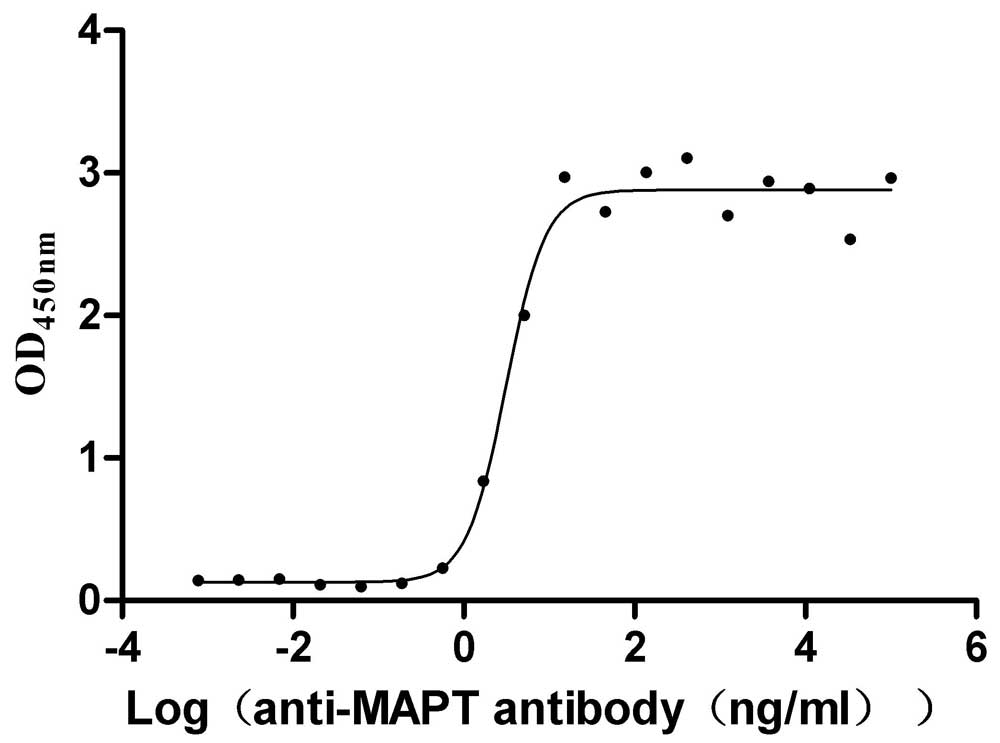Recombinant Human Cytochrome b-c1 complex subunit 7 (UQCRB)
-
中文名称:人UQCRB重组蛋白
-
货号:CSB-YP025664HU
-
规格:
-
来源:Yeast
-
其他:
-
中文名称:人UQCRB重组蛋白
-
货号:CSB-EP025664HU
-
规格:
-
来源:E.coli
-
其他:
-
中文名称:人UQCRB重组蛋白
-
货号:CSB-EP025664HU-B
-
规格:
-
来源:E.coli
-
共轭:Avi-tag Biotinylated
E. coli biotin ligase (BirA) is highly specific in covalently attaching biotin to the 15 amino acid AviTag peptide. This recombinant protein was biotinylated in vivo by AviTag-BirA technology, which method is BriA catalyzes amide linkage between the biotin and the specific lysine of the AviTag.
-
其他:
-
中文名称:人UQCRB重组蛋白
-
货号:CSB-BP025664HU
-
规格:
-
来源:Baculovirus
-
其他:
-
中文名称:人UQCRB重组蛋白
-
货号:CSB-MP025664HU
-
规格:
-
来源:Mammalian cell
-
其他:
产品详情
-
纯度:>85% (SDS-PAGE)
-
基因名:
-
Uniprot No.:
-
别名:UQCRB; UQBP; Cytochrome b-c1 complex subunit 7; Complex III subunit 7; Complex III subunit VII; QP-C; Ubiquinol-cytochrome c reductase complex 14 kDa protein
-
种属:Homo sapiens (Human)
-
蛋白长度:Full Length of Mature Protein
-
表达区域:2-111
-
氨基酸序列AGKQAVSAS GKWLDGIRKW YYNAAGFNKL GLMRDDTIYE DEDVKEAIRR LPENLYNDRM FRIKRALDLN LKHQILPKEQ WTKYEEENFY LEPYLKEVIR ERKEREEWAK K
-
蛋白标签:Tag type will be determined during the manufacturing process.
The tag type will be determined during production process. If you have specified tag type, please tell us and we will develop the specified tag preferentially. -
产品提供形式:Lyophilized powder
Note: We will preferentially ship the format that we have in stock, however, if you have any special requirement for the format, please remark your requirement when placing the order, we will prepare according to your demand. -
复溶:We recommend that this vial be briefly centrifuged prior to opening to bring the contents to the bottom. Please reconstitute protein in deionized sterile water to a concentration of 0.1-1.0 mg/mL.We recommend to add 5-50% of glycerol (final concentration) and aliquot for long-term storage at -20℃/-80℃. Our default final concentration of glycerol is 50%. Customers could use it as reference.
-
储存条件:Store at -20°C/-80°C upon receipt, aliquoting is necessary for mutiple use. Avoid repeated freeze-thaw cycles.
-
保质期:The shelf life is related to many factors, storage state, buffer ingredients, storage temperature and the stability of the protein itself.
Generally, the shelf life of liquid form is 6 months at -20°C/-80°C. The shelf life of lyophilized form is 12 months at -20°C/-80°C. -
货期:Delivery time may differ from different purchasing way or location, please kindly consult your local distributors for specific delivery time.Note: All of our proteins are default shipped with normal blue ice packs, if you request to ship with dry ice, please communicate with us in advance and extra fees will be charged.
-
注意事项:Repeated freezing and thawing is not recommended. Store working aliquots at 4°C for up to one week.
-
Datasheet :Please contact us to get it.
相关产品
靶点详情
-
功能:Component of the ubiquinol-cytochrome c oxidoreductase, a multisubunit transmembrane complex that is part of the mitochondrial electron transport chain which drives oxidative phosphorylation. The respiratory chain contains 3 multisubunit complexes succinate dehydrogenase (complex II, CII), ubiquinol-cytochrome c oxidoreductase (cytochrome b-c1 complex, complex III, CIII) and cytochrome c oxidase (complex IV, CIV), that cooperate to transfer electrons derived from NADH and succinate to molecular oxygen, creating an electrochemical gradient over the inner membrane that drives transmembrane transport and the ATP synthase. The cytochrome b-c1 complex catalyzes electron transfer from ubiquinol to cytochrome c, linking this redox reaction to translocation of protons across the mitochondrial inner membrane, with protons being carried across the membrane as hydrogens on the quinol. In the process called Q cycle, 2 protons are consumed from the matrix, 4 protons are released into the intermembrane space and 2 electrons are passed to cytochrome c.
-
基因功能参考文献:
- Our results provide novel insights into the critical role of UQCRB in regulating CRC, supporting UQCRB as a new candidate for the development of diagnostics for CRC patients. PMID: 29147009
- The knockdown of UQCRB gene by UQCRB siRNA significantly inhibited the cancer stem cell-like phenotypes as well as the expression of stemness markers by blocking mitochondrial ROS/HIF1alpha/cMet pathway in U87MG GSCs. PMID: 29115404
- UQCRB gene mutation is associated with mitochondrial complex III deficiency in a Chinese family. PMID: 28604960
- a UQCRB mutation promotes angiogenesis through the generation of mitochondrial reactive oxygen species PMID: 25446085
- Mitochondrial UQCRB regulates VEGFR2 signaling in endothelial cells. PMID: 23708980
- Studies indicate that mitochondrial oxygen sensor ubiquinol-cytochrome c reductase binding protein (UQCRB) as a terpestacin-binding protein. PMID: 23475074
- Two SNPs in the 3' untranslated region of UQCRB (complex III), rs7836698 and rs10504961, were associated with overall survival. PMID: 22545919
显示更多
收起更多
-
相关疾病:Mitochondrial complex III deficiency, nuclear 3 (MC3DN3)
-
亚细胞定位:Mitochondrion inner membrane; Peripheral membrane protein; Matrix side.
-
蛋白家族:UQCRB/QCR7 family
-
数据库链接:
HGNC: 12582
OMIM: 191330
KEGG: hsa:7381
STRING: 9606.ENSP00000287022
UniGene: Hs.131255
Most popular with customers
-
Recombinant Human Claudin-18.2 (CLDN18.2)-VLPs (Active)
Express system: Mammalian cell
Species: Homo sapiens (Human)
-
Recombinant Macaca mulatta Microtubule-associated protein tau (MAPT) (Active)
Express system: Mammalian cell
Species: Macaca mulatta (Rhesus macaque)
-
Recombinant Human IL12B&IL12A Heterodimer Protein (Active)
Express system: Mammalian cell
Species: Homo sapiens (Human)
-
Recombinant Human Desmoglein-2 (DSG2), partial (Active)
Express system: Mammalian cell
Species: Homo sapiens (Human)
-
Recombinant Human Cadherin-17 (CDH17), partial (Active)
Express system: Mammalian cell
Species: Homo sapiens (Human)
-
Recombinant Macaca fascicularis CUB domain containing protein 1 (CDCP1), partial (Active)
Express system: Mammalian cell
Species: Macaca fascicularis (Crab-eating macaque) (Cynomolgus monkey)
-
Recombinant Human Gastric inhibitory polypeptide receptor(GIPR),partial (Active)
Express system: Mammalian cell
Species: Homo sapiens (Human)
-
Express system: Mammalian cell
Species: Macaca mulatta (Rhesus macaque)


-AC1.jpg)

















